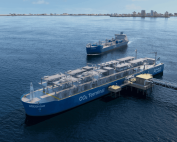Offshore wind power is needed to meet the growing electricity demand, argues Swedish wind energy association Svensk Vindenergi. The investors call for several reforms to accelerate the development of wind turbines in offshore areas.
Sweden and domestic industry have embarked on an energy transition path. Companies are trying to implement “green” steel production, while demanding access to cheap electricity. This is guaranteed by RES, in particular wind energy. It is high time that wind energy is also developed in offshore areas, Svensk Vindenergi argues. A Swedish industry organization has commissioned energy market analysis firm Thema Consulting Group to study Sweden’s future electricity demand and offshore wind potential. The analysis shows that electricity demand in Sweden is growing rapidly and could reach 370 TWh by 2050, almost three times the current electricity consumption of 140 TWh.
Sweden’s offshore wind energy has great potential to meet the growing demand for electricity. By 2050, offshore wind could account for 167 TWh, or nearly half of projected electricity demand. Significant growth in offshore wind could occur as early as 2030.
Postulates
– Political impasses and conflicts must be put aside in favor of a broad consensus on the potential of offshore wind power to rapidly electrify Sweden, argues Daniel Badman, CEO of Svensk Vinenergi. Investors are calling for reforms that would help develop offshore wind in Sweden. – Offshore wind energy can contribute on a large scale to industry change. Fundamental reforms are needed now for investment to gain momentum, the industry argues.
Among the desired reforms listed:
- Providing municipalities with the potential to generate offshore wind, or other electricity generated without fossil fuels, with clear financial incentives to participate in electricity generation.
- Strengthening of the grid and considering the potential of offshore wind to provide large amounts of electricity as part of grid development. Consideration of offshore wind in the design of support services.
- Marine plans should provide for increased use of offshore wind energy. Development of a concrete action plan to enable the implementation of offshore wind power and improve the national organization for electrification.
- Simplifying and shortening of the permitting process for offshore wind. Ensuring that the benefits of implementation are factored into the permit decision, such as climate benefits. Revising the rules to make municipal approvals more legally certain, introducing a more predictable system for evaluating force authorizations, and coordinating the work of relevant authorities and ministries to streamline decision-making processes. Major infrastructure investments require a long-term perspective.
These items were followed by signatures:
– Hillevi Priscar, Country Manager Sweden, OX2
– Roland Flaig, Managing Director, RWE Renewables Sweden
– Mattias Wärn, CEO and co-founder, Svea Vind Offshore
– Olle Hedberg, Managing Director, wpd Offshore Sweden
– Peter Obling, European Business Development Director of Offshore Wind Energy, Ørsted
– Daniel Badman, CEO, Svensk Vindenergi
Source: Svensk Vindenergi















